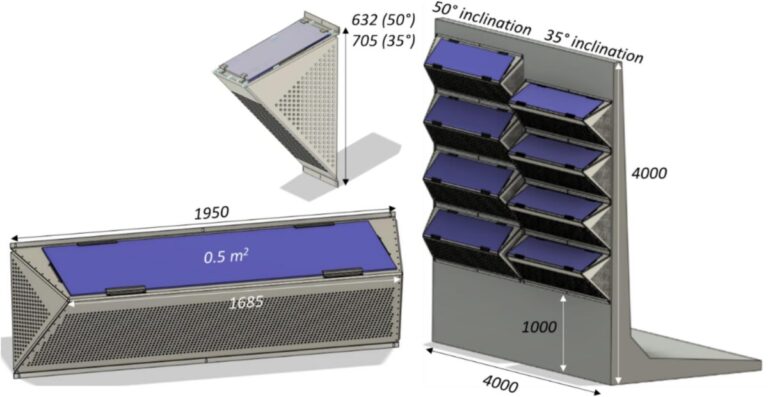A Belgian-Dutch research group has designed a PV noise barrier that reportedly delivers good performance in terms of power output, driver safety and noise suppression. The payback period was estimated at six to ten years.
A Belgian-Dutch research team has developed a photovoltaic noise barrier with a ZigZag design for applications along (highway) roads, but also in facade applications of buildings. “Especially in densely populated areas, such as Eindhoven, space for PV installations is limited and living comfort in neighborhoods close to highways is under pressure,” says Fallon Colberts, lead author of the study. pv magazine. “ZigZag PV noise barriers are an excellent solution.”
The ZigZag design consists of mounting the solar panels towards the sun in a “zig” plane, while the “zag” plane increases the light coupling with the underlying solar panel.
“Because the solar panel faces the sun and not the driver, this design can reduce unwanted sun and traffic light reflections on the glass surface of the solar panel, contributing to driver safety.” the scientists explained, noting that the new sound barrier also integrates sound-absorbing materials to reduce unwanted reflections of traffic noise. “In addition, driver safety can be increased by the aesthetic ‘saw’ of the construction, which avoids monotonous views.”
With the support of Netherlands-based startup Wallvision, the research group built a 4 x 4 m demonstrator with a south-south-west orientation and two ZigZag configurations. It relied on eight solar panels from Belgian manufacturer Soltech and Fiber Bragg Grating (FBG) sensors intended to measure system temperature. Sound-absorbing material from the German specialist Rockwool was also used. The modules were deployed with a tilt angle ranging from 35 to 50 degrees.
Through a series of simulations and life cycle assessment (LCA), the researchers found that the proposed PV sound barrier has a payback period of 6 to 10 years. “LCA studies conducted by Helmo revealed a low CO2 eq/kWh compared to electricity mixes and a good payback period over the entire lifespan,” says Colberts. “In addition, the simulations showed that the energy yield can be simulated very well by their optimized energy yield framework. The latter could be interesting when designing and selecting locations for the installation of ZigZag PV noise barriers.”
The analysis also showed that the optimal tilt angle of the system should be between 20 and 40 degrees, which should ensure a good balance between output and noise reduction. However, in terms of energy output, no specific difference was noted when changing the tilt angle from 20 to 80 degrees.
The simulations also showed that a tilt angle of 50 degrees generally produces higher energy production in different seasons compared to a tilt angle of 35 degrees, especially in the summer months. “The reason for this is the reduced shading of the upper ZigZag covers with a higher tilt angle,” the scientists explained. “An annual specific output of up to 941 kWh/kWp at a tilt angle of 35 degrees and 1066 kWh/kWp at a tilt angle of 50 degrees can be generated by the ZigZag PVNB demonstrator.”
The system was presented in the study “Performance study and LCA of a ZigZag PV noise barrier: towards mass adaptation of IIPV applications”, published in Applied energy. The research team consisted of scientists from Zuyd University of Applied Sciences in the Netherlands, but also from Hasselt University and the Institut de Recherche des Instituts groupés de la Haute Ecole Mosane in Belgium.
“Wallvision is working on optimizing its product to realize the commercialization of ZigZag PV components that can be used for the construction of PV noise barriers,” said Colberts. “A pilot project in Eindhoven is planned by Wallvision in the near future to bring ZigZag PV noise barriers closer to commercialization.”
This content is copyrighted and may not be reused. If you would like to collaborate with us and reuse some of our content, please contact: editors@pv-magazine.com.


